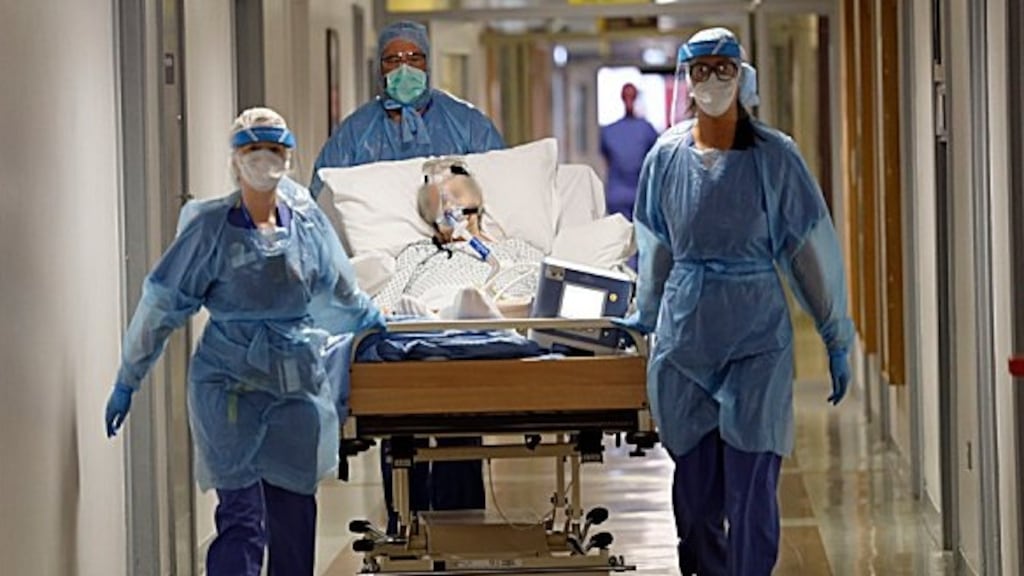Ireland is outperforming almost all European countries in controlling the spread of Covid-19, the National Health Emergency Team has said. However it also warned that continued and sustained efforts were needed to contain the virus.
Data presented by the team on Friday show that almost all European countries have seen an increase in the seven-day incidence of the virus, ranging from 2 per cent to 59 per cent, compared to the previous week.
The same metric shrank in only four countries in Europe, one of which was Ireland, which saw a 30 per cent fall in the week up to Friday. The Republic now ranks 20th overall on this measurement.
Hospital Report
The team on Friday reported the first positive trends in the data for three months, but sounded a note of caution of the spread of the virus in older cohorts in particular which have seen incidence rates increase just as they have declined among younger people.
While there have been significant reductions in the 19-24 age group, the incidence in the 75-84 age group has grown from 70 per 100,000 of population to 184 in recent weeks.
‘System stable’
Chief clinical officer of the HSE Dr Colm Henry said the hospital system is “currently stable”, with 325 cases in hospital and 42 in intensive care. He warned, however, that “we are only ever a few weeks away from healthcare systems becoming overwhelmed”.
The Department of Health reported 772 new cases of Covid-19 and six deaths. There have now been a total of 61,059 cases of the disease diagnosed in the State, and 1,908 deaths linked to the virus. There have been 96 deaths in October, 34 of which are in nursing homes – this compares to a total of 36 deaths in September and five in August. The R number is estimated to be about 1, with the team estimating that it should be at about 0.5 in order to get case numbers to approximately 100 per day by the end of the six-week period of restrictions.
As the key indicators of the disease in Ireland continue to fall, Prof Philip Nolan of the Irish Epidemiological Modelling Advisory Group said he was in a position to report positive trends in the data for the first time in months.
“This is the first time in three months that I’ve been able to report positive indications that we are starting to suppress transmission of the virus,” said Prof Nolan. “When we achieve this sort of suppression, the important thing is to make it last.”
Data show that the recent surge of the virus peaked with a seven-day average of new cases about 1,200 last week. As of Friday, the seven-day average is down to 836.
Incidence
The 14-day incidence of the disease per 100,000 of population, another key metric, peaked at about 310 to 287. While case numbers are declining, hospitalisations continue to increase, albeit they have departed from the exponential growth seen in recent weeks.
The reversal being seen in the growth of the virus, said Prof Nolan, was down to the introduction of a ban on household mixing rather than the Level 3 restrictions that were in place beforehand, or the Level 5 restrictions introduced on October 21st.
The effect of Level 5 will not be reflected in the number of cases being diagnosed for another week or so, he said. Once those measures are reflected in the case numbers, “we’ll have a much clearer picture of are we on track to be where we need to be at the end of the six week period”.
The team remain concerned, however, that the reduction could be reversed, based on the experience of Dublin after Level 3 measures were introduced in September. While cases there stabalised for about two weeks, they then rose precipitously, doubling over 10 days.
Chief medical officer Dr Tony Holohan said the team did not have any concerns about schools reopening next week. He reiterated the team’s view that its analysis shows that transmission in schools is low and they are not a high-risk environment.
Winter worries
Earlier in the day HSE chief executive Paul Reid said it is difficult predict when Covid-19 cases will peak during this winter.
One reason for this is the time lag between cases in younger people moving on to those in the over-65 age group, he said. This lag, between cases in those between 18 to 25 years of age and those among older and more vulnerable people, was not unique to Ireland and was also evident in other countries, he added.
He said while evidence is emerging of Level 3 and Level 5 measures beginning to have an impact, there is a need for caution.
Mr Reid said while there had been an easing in the positivity rates in Ireland recently, the number of people in hospital and intensive care units continues to rise.
Mr Reid also said there was no agreement in place to provide intensive care beds for patients from Northern Ireland but the HSE would do so if requested.
“There have been various levels of engagement with Northern Ireland health service, but no formal request for help yet. Should a request be made, we would be willing to help.”
With regards to nursing homes, Mr Reid said four nursing homes are dealing with a serious Covid-19 outbreak and 25 others are receiving a range of supports.












